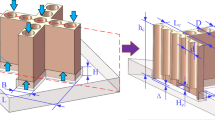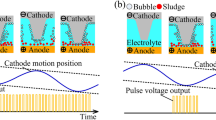Abstract
With respect to deep narrow groove structures with high length-width ratio and high depth-width ratio (particularly when the ratio is greater than 10), the cathode rigidity and flow-field stability deteriorate during the electrochemical machining (ECM) process. To improve the machining efficiency and process stability of deep narrow grooves with high length-width ratio, a hollow slice cathode with stiffeners was designed and optimized to meet the rigid requirements using the method of one-way fluid-solid coupling finite element analysis. Additionally, the effects of cathode stiffener size, stiffener distribution, and cathode vibrating feed mode on the flow field in the machining gap were investigated using the flow-field simulation analysis method. The simulation results indicate that cavitation and electrolyte starvation in the machining gap are avoided with a reasonable stiffener design, and the renewal of electrolyte in the machining gap is improved with a reasonable vibration motion. Contrast experiments were performed based on the simulation results. The experimental results verified that the optimal design of stiffeners and the reasonable cathode vibration improve the stability of the flow field. Moreover, process stability and machining efficiency of ECM of deep narrow grooves with high length-width ratio improve with the adoption of the optimal vibrating feed parameters.
Similar content being viewed by others
References
Ayesta I, Izquierdo B, Sánchez JA, Ramos JM, Plaza S, Pombo I, Ortega N, Bravo H, Fradejas R, Zamakona I (2013) Influence of EDM parameters on slot machining in C1023 aeronautical alloy[J]. Procedia CIRP 6(7):129–134. https://doi.org/10.1016/j.procir.2013.03.059
Zhang ZK, Yue ZF, Wen ZX, Wang BZ, Liu DS (2014) Study on fatigue properties of turbine disk groove modeling specimens of GH4720 alloy[J]. Rare Metal Mater Eng 43(1):42–46
Shamoto E, Saito A (2016) A novel deep groove machining method utilizing variable-pitch end mill with feed-directional thin support[J]. Precis Eng 43:277–284. https://doi.org/10.1016/j.precisioneng.2015.08.006
Lin CT, Chow HM, Yang LD, Chen YF (2007) Feasibility study of micro-slit EDM machining using pure water [J]. Int J Adv Manuf Technol 34(1):104–110. https://doi.org/10.1007/s00170-006-0570-y
Moroki A, Kitano R, Obara M, Tsuda H (2005) Femtosecond laser processing using subwavelength thin metal slit arrays[J]. Jpn J Appl Phys 44(12):8753–8758. https://doi.org/10.1143/JJAP.44.8753
Raja K, Ravikumar R (2016) A review on electrochemical machining processes[J]. Int J Appl Eng Res 11(4):2354–2355
Lohrengel MM, Rataj KP, Schubert N, Schneider M, Höhn S, Michaelis A, Hackert-Oschätzchen M, Martin A, Schubert A (2014) Electrochemical machining of hard metals-WC/Co as example[J]. Powder Metall 57(1):21–30. https://doi.org/10.1179/1743290113Y.0000000062
Wang MH, Liu WS, Peng W (2014) Multiphysics research in electrochemical machining of internal spiral hole[J]. Int J Adv Manuf Technol 74(5):749–756. https://doi.org/10.1007/s00170-014-5938-9
Rathod V, Doloi B, Bhattacharyya B (2015) Influence of electrochemical micromachining parameters during generation of microgrooves [J]. Int J Adv Manuf Technol 76(1):51–60. https://doi.org/10.1007/s00170-013-5304-3
Wang F, Zhao JS, Zhang XL, Yang ZW, Gan WM, Tian ZJ (2017) Electrochemical machining of a narrow slit by cathodic compound feeding [J]. Int J Adv Manuf Technol 90(1):971–978. https://doi.org/10.1007/s00170-016-9448-9
Liu GX, Zhang YJ, Jiang SZ, Liu JW, Gyimah GK, Luo HP (2016) Investigation of pulse electrochemical sawing machining of micro-inner annular groove on metallic tube [J]. Int J Mach Tool Manu 102:22–34. https://doi.org/10.1016/j.ijmachtools.2015.12.001
Chen H, Wang YK, Wang ZL, Wang ZL, Zhao WS (2011) Electrochemical milling of micro slot [J]. Nanotechnol Precis Eng 9(1):83–88 (In Chinese)
Liu J, Jiang X, Zhu D (2016) Electrochemical machining of multiple slots with low-frequency tool vibrations [J]. Procedia CIRP 42:799–803
Xu HY, Zhu D (2005) Investigation for precision electrochemical machining of narrow grooves [J]. Mech Sci Technol (In Chinese)
Xu JW, Yun NZ, Wang JY, Tian JA, Xu WJ (2008) Electrochemical machining technique [M]. National Defense Industry Press, Beijing, pp 46–47 (In Chinese)
Qu NS, Hu Y, Zhu D, Xu ZY (2014) Electrochemical machining of blisk channels with progressive-pressure electrolyte flow [J]. Mater Manuf Process 29(5):572–578. https://doi.org/10.1080/10426914.2014.892974
Skoczypiec S, Ruszaj A (2007) Application of ultrasonic vibration to improve technological factors in electrochemical machining of titanium alloys[C]//scripts precision and microproduction. Engineering:143–148
Pan Y, Xu L (2015) Vibration analysis and experiments on electrochemical micro-machining using cathode vibration feed system [J]. Int J Precis Eng Manuf 16(1):143–149. https://doi.org/10.1007/s12541-015-0018-0
Zhao JS, Wang F, Liu Z, Liu Z, Zhang XL, Gan WM, Tian ZJ (2016) Flow field design and process stability in electrochemical machining of diamond holes [J]. Chin J Aeronaut (6):1830–1839
Acknowledgements
This research is sponsored by the National Natural Science Foundation of China (Granted No. 51205212 and No. 51475235), Natural Science Foundation of Jiangsu Province (Granted No. BK20161193), Funding for Outstanding Doctoral Dissertation in NUAA (Granted No. BCXJ16-05), and Funding for Graduate Innovation Center in NUAA (Granted No. kfjj20160504).
Author information
Authors and Affiliations
Corresponding author
Rights and permissions
About this article
Cite this article
Zhao, J., Lv, Y., Wang, F. et al. Experimental research on process stability in pulsed electrochemical machining of deep narrow grooves with high length-width ratio. Int J Adv Manuf Technol 96, 2245–2256 (2018). https://doi.org/10.1007/s00170-018-1610-0
Received:
Accepted:
Published:
Issue Date:
DOI: https://doi.org/10.1007/s00170-018-1610-0




